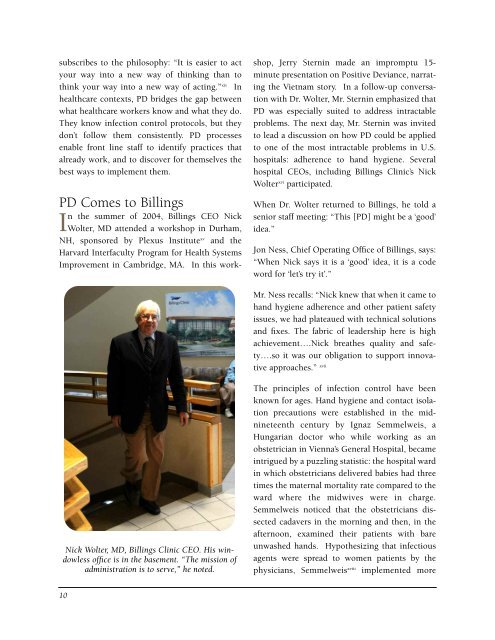From Invisible to Visible - Positive Deviance Initiative
From Invisible to Visible - Positive Deviance Initiative
From Invisible to Visible - Positive Deviance Initiative
You also want an ePaper? Increase the reach of your titles
YUMPU automatically turns print PDFs into web optimized ePapers that Google loves.
subscribes <strong>to</strong> the philosophy: “It is easier <strong>to</strong> act<br />
your way in<strong>to</strong> a new way of thinking than <strong>to</strong><br />
think your way in<strong>to</strong> a new way of acting.” xiv In<br />
healthcare contexts, PD bridges the gap between<br />
what healthcare workers know and what they do.<br />
They know infection control pro<strong>to</strong>cols, but they<br />
don’t follow them consistently. PD processes<br />
enable front line staff <strong>to</strong> identify practices that<br />
already work, and <strong>to</strong> discover for themselves the<br />
best ways <strong>to</strong> implement them.<br />
PD Comes <strong>to</strong> Billings<br />
In the summer of 2004, Billings CEO Nick<br />
Wolter, MD attended a workshop in Durham,<br />
NH, sponsored by Plexus Institute xv and the<br />
Harvard Interfaculty Program for Health Systems<br />
Improvement in Cambridge, MA. In this workshop,<br />
Jerry Sternin made an impromptu 15-<br />
minute presentation on <strong>Positive</strong> <strong>Deviance</strong>, narrating<br />
the Vietnam s<strong>to</strong>ry. In a follow-up conversation<br />
with Dr. Wolter, Mr. Sternin emphasized that<br />
PD was especially suited <strong>to</strong> address intractable<br />
problems. The next day, Mr. Sternin was invited<br />
<strong>to</strong> lead a discussion on how PD could be applied<br />
<strong>to</strong> one of the most intractable problems in U.S.<br />
hospitals: adherence <strong>to</strong> hand hygiene. Several<br />
hospital CEOs, including Billings Clinic’s Nick<br />
Wolter xvi participated.<br />
When Dr. Wolter returned <strong>to</strong> Billings, he <strong>to</strong>ld a<br />
senior staff meeting: “This [PD] might be a ‘good’<br />
idea.”<br />
Jon Ness, Chief Operating Office of Billings, says:<br />
“When Nick says it is a ‘good’ idea, it is a code<br />
word for ‘let’s try it’.”<br />
Mr. Ness recalls: “Nick knew that when it came <strong>to</strong><br />
hand hygiene adherence and other patient safety<br />
issues, we had plateaued with technical solutions<br />
and fixes. The fabric of leadership here is high<br />
achievement….Nick breathes quality and safety….so<br />
it was our obligation <strong>to</strong> support innovative<br />
approaches.” xvii<br />
Nick Wolter, MD, Billings Clinic CEO. His windowless<br />
office is in the basement. “The mission of<br />
administration is <strong>to</strong> serve,” he noted.<br />
The principles of infection control have been<br />
known for ages. Hand hygiene and contact isolation<br />
precautions were established in the midnineteenth<br />
century by Ignaz Semmelweis, a<br />
Hungarian doc<strong>to</strong>r who while working as an<br />
obstetrician in Vienna’s General Hospital, became<br />
intrigued by a puzzling statistic: the hospital ward<br />
in which obstetricians delivered babies had three<br />
times the maternal mortality rate compared <strong>to</strong> the<br />
ward where the midwives were in charge.<br />
Semmelweis noticed that the obstetricians dissected<br />
cadavers in the morning and then, in the<br />
afternoon, examined their patients with bare<br />
unwashed hands. Hypothesizing that infectious<br />
agents were spread <strong>to</strong> women patients by the<br />
physicians, Semmelweis xviii implemented more<br />
10

















